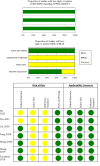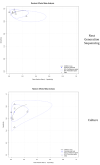Higher sensitivity and accuracy of synovial next-generation sequencing in comparison to culture in diagnosing periprosthetic joint infection: a systematic review and meta-analysis
- PMID: 36244018
- PMCID: PMC10435641
- DOI: 10.1007/s00167-022-07196-9
Higher sensitivity and accuracy of synovial next-generation sequencing in comparison to culture in diagnosing periprosthetic joint infection: a systematic review and meta-analysis
Abstract
Purpose: The purpose of this meta-analysis was to compare the diagnostic parameters of synovial next-generation sequencing (NGS) and cultures in diagnosing periprosthetic joint infections (PJI).
Methods: PubMed, Web of Science, Cochrane, and Google Scholar were searched from inception until 8 Jan 2022 for literature investigating the role of NGS in comparison to culture in the diagnosis of PJI. The studies were included if they investigated the diagnostic value of culture and NGS in diagnosing PJIs against the Musculoskeletal Infection Society (MSIS) criteria. Diagnostic parameters, such as sensitivity, specificity, positive predictive value, negative predictive value, positive-likelihood ratio, negative-likelihood ratio, accuracy, and area under the curve (AUC), were calculated for the included studies to evaluate the performance of NGS in comparison to culture in PJI diagnosis.
Results: The total number of the included patients was 341 from seven articles. The pooled sensitivity, specificity, and diagnostic odds ratio of NGS were 94% (95% CI 91-97%), 89% (95% CI 82-95%), and 138.5 (95% CI 49.1-390.5), respectively. NGS has positive- and negative-likelihood ratios of 7.9 (95% CI 3.99-15.6) and 0.1 (95% CI 0.0-0.1), respectively. On the other hand, the pooled sensitivity, specificity, and diagnostic odds ratio of culture were 70% (95% CI 61-79%), 94% (95% CI 88-98%), and 28.0 (95% CI 12.6-62.2), respectively. The SROC curve for NGS showed that the accuracy (AUC) was 91.9%, and that the positive and negative predictive values were 8.6 (95% CI 5.0-19.5) and 0.1 (95% CI 0.0-0.1), respectively. While, culture SROC curve demonstrated that the accuracy (AUC) was 80.5% and the positive- and negative-likelihood ratio were 12.1 (95% CI 4.5-49.6) and 0.3 (95% CI 0.2-0.4).
Conclusions: NGS has a potential role in diagnosing hip and knee PJIs due to its high sensitivity, specificity, and accuracy. However, the sensitivity and specificity reported by the studies varied according to the time of synovial sampling (preoperative, postoperative, or mixed).
Keywords: Arthroplasty; Culture; Diagnosis; Next-generation sequencing; Periprosthetic joint infection.
© 2022. The Author(s).
Conflict of interest statement
The authors have no financial or proprietary interests in any material discussed in this article. All authors declared no conflict of interest.
Figures





Similar articles
-
Diagnostic Value of Next-Generation Sequencing in Periprosthetic Joint Infection: A Systematic Review.Orthop Surg. 2022 Feb;14(2):190-198. doi: 10.1111/os.13191. Epub 2021 Dec 21. Orthop Surg. 2022. PMID: 34935279 Free PMC article.
-
Synovial calprotectin in prosthetic joint infection. A systematic review and meta-analysis of the literature.Arch Orthop Trauma Surg. 2024 Dec;144(12):5217-5227. doi: 10.1007/s00402-024-05416-0. Epub 2024 Jul 8. Arch Orthop Trauma Surg. 2024. PMID: 38972902 Free PMC article.
-
Utility of intraoperative frozen section histopathology in the diagnosis of periprosthetic joint infection: a systematic review and meta-analysis.J Bone Joint Surg Am. 2012 Sep 19;94(18):1700-11. doi: 10.2106/JBJS.J.00756. J Bone Joint Surg Am. 2012. PMID: 22992880
-
The Effectiveness of Metagenomic Next-Generation Sequencing in the Diagnosis of Prosthetic Joint Infection: A Systematic Review and Meta-Analysis.Front Cell Infect Microbiol. 2022 Jun 10;12:875822. doi: 10.3389/fcimb.2022.875822. eCollection 2022. Front Cell Infect Microbiol. 2022. PMID: 35755833 Free PMC article.
-
Signs and symptoms to determine if a patient presenting in primary care or hospital outpatient settings has COVID-19.Cochrane Database Syst Rev. 2022 May 20;5(5):CD013665. doi: 10.1002/14651858.CD013665.pub3. Cochrane Database Syst Rev. 2022. PMID: 35593186 Free PMC article.
Cited by
-
The impact of surgical approach in total hip arthroplasty on the organisms profile of periprosthetic joint infections? A systematic review and meta-analysis.Arch Orthop Trauma Surg. 2025 May 15;145(1):293. doi: 10.1007/s00402-025-05881-1. Arch Orthop Trauma Surg. 2025. PMID: 40372454
-
Preoperative Synovial Fluid Cultures, and Biopsy Cultures After Dry Tap Aspiration, Are Valuable in Diagnosing a Periprosthetic Joint Infection: A Retrospective Study.Microorganisms. 2025 Mar 1;13(3):562. doi: 10.3390/microorganisms13030562. Microorganisms. 2025. PMID: 40142454 Free PMC article.
-
Advances in the Microbiological Diagnosis of Prosthetic Joint Infections.Diagnostics (Basel). 2023 Feb 20;13(4):809. doi: 10.3390/diagnostics13040809. Diagnostics (Basel). 2023. PMID: 36832297 Free PMC article. Review.
-
Multiplex PCR in septic arthritis and periprosthetic joint infections microorganism identification: Results from the application of a new molecular testing diagnostic algorithm.J Exp Orthop. 2024 Jul 21;11(3):e12097. doi: 10.1002/jeo2.12097. eCollection 2024 Jul. J Exp Orthop. 2024. PMID: 39035845 Free PMC article.
-
Comparison of metagenomic next-generation sequencing and conventional culture for the diagnostic performance in febrile patients with suspected infections.BMC Infect Dis. 2024 Mar 26;24(1):350. doi: 10.1186/s12879-024-09236-w. BMC Infect Dis. 2024. PMID: 38532348 Free PMC article.
References
-
- Bukowska-Ośko I, Perlejewski K, Nakamura S, et al. Sensitivity of next-generation sequencing metagenomic analysis for detection of RNA and DNA viruses in cerebrospinal fluid: the confounding effect of background contamination. respiratory treatment and prevention. Adv Exp Med Biol. 2016 doi: 10.1007/5584_2016_42. - DOI - PubMed
Publication types
MeSH terms
Substances
LinkOut - more resources
Full Text Sources
Medical

